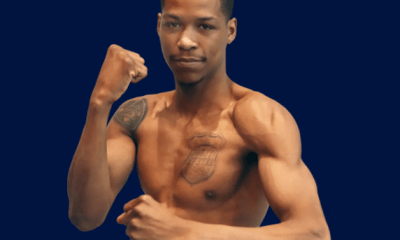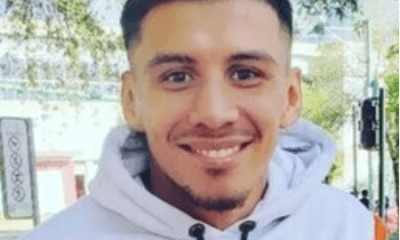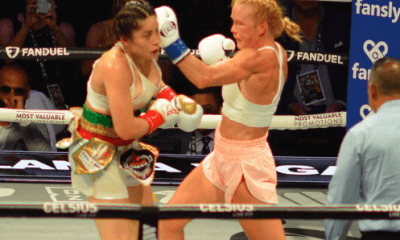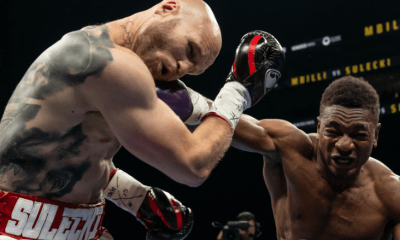Featured Articles
What’s Your Favorite Boxing Match? Rigby-Ayers Tops My List
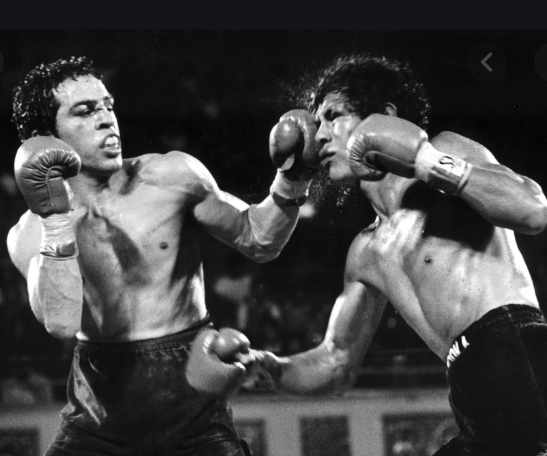
Many count Castillo vs. Corrales (2005) as their favorite. Fans of an earlier generation were partial to Graziano vs. Zale (1947), Pep vs. Saddler (1949), DeMarco vs. Basilio (1955), and Durelle vs. Moore (1958). The “War” between Hagler and Hearns (1985) rightfully tops many lists. When Hearns came out fast at the opening bell only to be met by a bald-headed monster, it was spine-tingling electricity at its best; it was anticipative mayhem.
Jorge Castro–John David Jackson (1994) was high drama. Morales-Barrera (2000) and Vazquez-Marquez (2008) showcased Mexican fighters who combined technique with a brawler’s proclivity and that amounted to an atomic cocktail. Mancini vs. Frias was short but furious.
Bobby Chacon’s 1982 battle with Rafael Limon, the most compelling and memorable of their four fights, was a classic and Chacon’s battle the next year with Cornelius Boza-Edwards was legendary. The first Gatti vs. Ward is at the top end of many memory banks and, of course, Ali’s bouts with Frazier and with Foreman are up there along with the frenzy of Pryor vs. Arguello (1982).
Lyle and Foreman exchanged bombs and knockdowns in 1976. Then in 1992, Michael Moorer and Bert Cooper did the same. These two brawls could easily be someone’s favorite. However, the Nardico-Norkus eight knockdown Pier Six in 1954 was quintessentially old school and it is on many leaderboards. Under the radar Muriqi vs. Ahmad (2002) was new school but could be any school for its back-and-forth mayhem.
The Tommy Morrison vs. Joe Hipp slugfest in Reno in 1992 was “bone crunching.” Morrison‘s jaw and both of his hands were broken, but Joe lost via a 9th round comeback stoppage by the “Duke.” Not to be outdone, Hipp suffered a complete shattering of his cheekbones.
Bruce Curry and Monroe Brooks put on their own version of “To Live and Die in LA” in 1978 at the Olympic Auditorium. For those who witnessed the fifth round of the incredible Somsak Sithchatchawal vs. Mahyar “Little Tyson” Monshipour savagery in 2006, Brooks-Curry was like that for almost nine full rounds. Neither man died in L.A.; they both lived on, but in different ways.
Thus, it seems that every serious fan, aficionado, or writer has that One favorite fight, the one that is indelible and is locked into the memory like concrete. Here are several on my list:
Lee Roy “Solid Gold” Murphy vs. Chisanda Mutti (1985)
One of the most unique happenings in a boxing match occurred in Monte Carlo in 1985 when Chicagoan Lee Roy “Solid Gold” Murphy (the IBF cruiserweight titleholder) and rugged Zambian Chisanda Mutti simultaneously scored brutal knockdowns in the waning moments of the fight. A badly hurt Murphy barely beat referee Larry Hazzard’s count while Mutti remained down and was counted out. The crowd was up and roaring in disbelief. Mutti had to be helped from the ring.
This was no Rocky movie; this was real and unforgettable and it came after an 11th round that had to be seen to be believed. In fact, the entire fight involved seesaw exchanges that were of the career-ending type.
Carl Thompson vs. Ezra Sellers (2001)
“Thompson looks to be hurt by every shot he takes, but then again so does Sellers.”—Spencer Oliver
High up on my list is Carl “The Cat” Thompson vs. the late Ezra Sellers, a classic match in 2001 (with the somewhat recalcitrant but prime Steve Smoger refereeing) that involved at least six official knockdowns; Thompson hit the deck four times, Sellers twice. This was no boxing match but rather a no-holds-barred fight between two very exciting punchers.
Going into the third round, both men had been staggered and dropped hard; both were on the verge of being put to sleep. Finally, Sellers became the Sandman when he KOd The Cat in the fourth round with a crunching counter right hook, ending a winning streak that started after Thompson lost to Johnny Nelson in 1999. Thompson had been knocked down many times, but he always got up. This time he was separated from his senses and sent to Feline Dreamland. He finally rose from the canvas to the applause of the stunned and worried crowd.
My Number One: Michael Ayers vs. Wayne Rigby (July 1, 2000)
“Squinting at features even more battered than his own, Michael Ayers could tell from the look of resignation in Wayne Rigby’s eyes that his opponent was finished. The fire which raged fiercely for 10 rounds had been doused. Then, with Rigby helpless and American referee Arthur Mercante Jr. hesitating, came a moment unique in boxing.” — Mike Lewis, The Telegraph
…a credit to the sport f—– nearly brought me to tears i would’ve emptied my pockets and thrown it in the ring. — poster named Tony Stephenson
It was a shining example of the old fight game at its noble best. — Mike Casey
This bout, which occurred at the Bowler’s Arena in Manchester, UK, had all the ingredients for a classic Brit dust-up and it didn’t disappoint. And like Mutti-Murphy, it also involved unique happenings. The participants were late-substitute Wayne Rigby (17-5) from Manchester and Michael “Shaka” Ayers (28-3-1) from London. “Shaka” was the IBO lightweight titleholder.
On paper, Ayers, a stylist, looked to be the strong favorite. In fact, the accomplished Ayers had stopped the highly rated Colin Dunn in 1996. But the Mancunian challenger Rigby came to fight.
In the early going Rigby started fast showing surprisingly fast hand speed and a punishing right uppercut that he landed repeatedly. Things heated up in the third round as both men exchanged bruising shots, but Rigby was dictating the action to this point.
In the 4th round, Ayers fought back using a variety of punches behind a good jab and tightened things up. Then, in the 6th, “Shaka” put the lad from Manchester down with a beautiful straight right, but he failed to close matters.
Rigby came storming back in the 7th as both men engaged in mutual savagery, but Ayers managed to get in two crunching blows just before the bell that probably won the round for him. Rigby was fortunate the bell rang.
Again, showing great recuperative powers in the 8th round, Rigby drilled Shaka with every punch in the book and finally landed two hammering left hooks that sent the Londoner to the canvas like he had been hit with a Bobby’s sap. Somehow, someway, the tough champion, who was in danger of being stopped for the first time in his long career, got up and signaled to Rigby at the bell that he had indeed been rocked. Mutual respect and uncommon sportsmanship was now in play. What else was in play was that Ayers was at risk of losing to a man, albeit a former British champion, who had taken the fight on short notice.
Ayers also showed his ability to recuperate as he came out fast in the 9th, but the round was Rigby’s as he forced the action with straight rights, hooks and uppercuts to the rousing approval of his hometown fans. However, he expended valuable energy in the process. Both men continued to engage in malefic violence. Ayer’s mouth was bleeding and Rigby’s eyes were badly bruised.
The first half of the tenth round was even as both combatants continued to engage in what had become a closet classic. Ayers then began to use effective stinging right crosses and right leads. He took control with 1:26 left and accelerated his assault until the gallant Rigby found himself with an empty tank.
Then it Happened!
With only 29 seconds left, Ayers signaled to Mercante that the fight should be stopped, but for some inexplicable reason Mercante was not responsive. Ayers then pummeled his helpless and badly bloodied opponent until both men signaled that enough was enough, touched gloves, and headed back to their corners. This occurred with just 14 seconds left.
It was a rare moment of poignancy that made those who witnessed it feel chills run down their spines.
Mercante finally put his arms around Rigby to officially halt the fight, but the two noble warriors had already taken away that important responsibility from him. In fact, Mercante’s potentially dangerous hesitation could well have resulted in Rigby taking career-altering punishment.
As Mike Lewis writes, “Dropping their hands, Ayers and Rigby decided there and then that this memorable bruising battle was over. They touched gloves, nodded at one another and headed back to their respective corners. [It was] an extraordinary finish to an extraordinary contest. Hardened Manchester ringsiders had never seen anything like it.
“Barry Hearn, my manager, said it was eerie,” recalled the then 36-year-old Londoner Ayers of his remarkable victory which went into the books as a TKO. “It was almost as though Wayne and myself had communicated through telepathy. Somehow he got it across to me that he’d taken enough and I stopped.”
But the very best quote came from Jerry Storey, Ayers’ Irish trainer, when he said, “Those two guys showed boxing still had a soul.”
Like most, I keep my own list of favorite fights. This one is at the top.
What’s yours?
Ted Sares can be reached at tedsares@roadrunner.com
To comment on this story in The Fight Forum CLICK HERE
-

 Featured Articles3 weeks ago
Featured Articles3 weeks agoAvila Perspective, Chap. 330: Matchroom in New York plus the Latest on Canelo-Crawford
-

 Featured Articles2 weeks ago
Featured Articles2 weeks agoVito Mielnicki Jr Whitewashes Kamil Gardzielik Before the Home Folks in Newark
-

 Featured Articles4 weeks ago
Featured Articles4 weeks agoAvila Perspective, Chap 329: Pacquiao is Back, Fabio in England and More
-

 Featured Articles3 weeks ago
Featured Articles3 weeks agoOpetaia and Nakatani Crush Overmatched Foes, Capping Off a Wild Boxing Weekend
-

 Featured Articles2 weeks ago
Featured Articles2 weeks agoCatching Up with Clay Moyle Who Talks About His Massive Collection of Boxing Books
-

 Featured Articles4 weeks ago
Featured Articles4 weeks agoFabio Wardley Comes from Behind to KO Justis Huni
-

 Featured Articles1 week ago
Featured Articles1 week agoMore Medals for Hawaii’s Patricio Family at the USA Boxing Summer Festival
-

 Featured Articles4 weeks ago
Featured Articles4 weeks agoDelving into ‘Hoopla’ with Notes on Books by George Plimpton and Joyce Carol Oates

